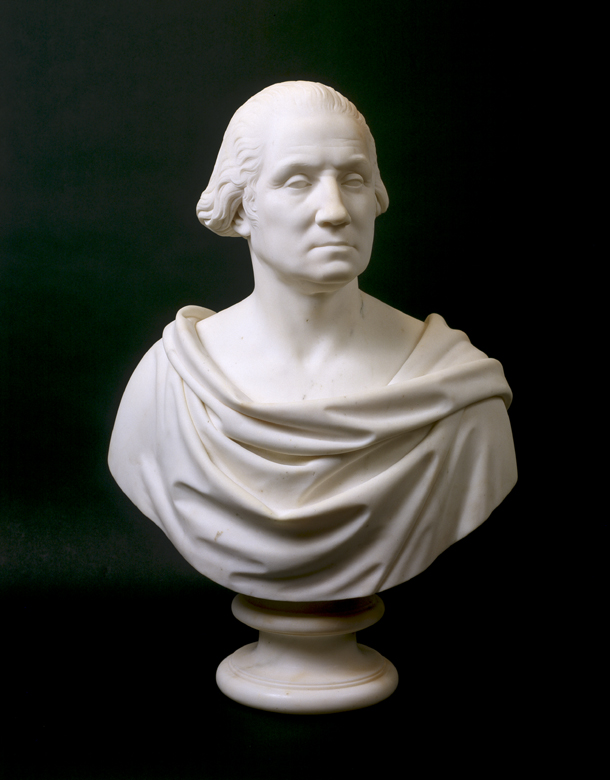
| Title | George Washington |
| Artist/Maker |
Unidentified
|
| Date | n. d. |
| Medium | Marble |
| Dimensions | h. 31.25 x w. 22.5 x d. 14.25 in. (h. 79.4 x w. 57.2 x d. 36.2 cm) |
| Credit Line | U.S. Senate Collection |
| Accession Number | 21.00020.000 |
In April 1966, the Joint Committee on the Library accepted a marble bust of George Washington from Mary Frances Drinker of Jenkintown, Pennsylvania. In her initial letter to Senator Everett Jordan of North Carolina, then chairman of the committee, the donor stated that the Washington bust–in the style of noted French sculptor Jean-Antoine Houdon–had belonged to her father, Henry Middleton Fisher, and had been on loan to the Philadelphia Museum of Art “for some years.” In recommending the acquisition of the bust to the Joint Committee, Architect of the Capitol J. George Stewart noted Washington’s close association with the design of the Capitol, adding that the first president had in fact laid the cornerstone for the building.
The artist of the Senate bust is unknown. While on loan to the Philadelphia Museum of Art from 1937 until its transfer to the Capitol in 1966, the bust was classified as “French, early 19th century.” The work resembles the 1785 study of Washington by Houdon. In that year, Houdon had traveled with three assistants to Washington’s home, Mount Vernon. There, he modeled a bust of the Revolutionary War hero in clay and made a life mask of Washington’s face. The sculptor and his assistants subsequently produced many versions of Washington, including busts, statuettes, and statues in plaster, bronze, and marble.
Gustavus Eisen, in his study Portraits of Washington, identifies four styles of Washington busts sculpted by Houdon. The Senate bust most closely corresponds to the version Eisen terms “chest covered with drapery in toga style.” [1] The sculptor of this bust, however, departed from Houdon’s classic likeness both in the drape of the toga (which is not held by a button on the right shoulder, as is the toga of Houdon’s bust) and in the wavy treatment of the hair.
1. Gustavus A. Eisen, Portraits of Washington, vol. 3 (New York: Robert Hamilton, 1932), 764.
George Washington, first president of the United States, earned the epithet Father of His Country for his great leadership, both in the fight for independence and in unifying the new nation under a central government. Washington was born in Westmoreland County, Virginia, and worked as a surveyor in his youth. In 1752 he inherited a family estate, Mount Vernon, upon the death of a half brother, Lawrence. Washington's military career began in 1753, when he accepted an appointment to carry a warning to French forces who had pushed into British territory in the Ohio valley. In subsequent military assignments, Washington distinguished himself against the French, first while aiding General Edward Braddock and later as commander-in-chief of all Virginia militia.
In 1758 Washington returned to civilian life as a gentleman-farmer at Mount Vernon and soon took a seat in the Virginia house of burgesses. As a planter, Washington had firsthand knowledge of the economic restrictions being imposed by Britain, and as a Virginia legislator, he supported political efforts to curtail British control of the colonies. Washington was selected to serve as a delegate to the first and second Continental Congresses, and in June 1775 he was chosen to command the American forces. He successfully led the Continental army through eight difficult years of war for independence.
In 1783, after the Revolution, Washington resigned his military commission to Congress at Annapolis, Maryland. Recognizing the need for a strong central government, he served as president of the federal convention charged with drafting the Constitution. Reluctantly, he accepted the will of his colleagues to become president of the new nation, and he was inaugurated in New York City on April 30, 1789. Contending with the ideological struggles within the government, and with hostilities between France and Great Britain, Washington greatly feared the growth of political parties and the dangers of foreign involvement. These issues impelled him to serve a second term as president.
His attempts to solve foreign relations issues during his second term resulted in Jay's Treaty (1794), a vain attempt to regulate trade and settle boundary disputes with Great Britain, and the Pinckney Treaty (1795), which successfully settled such issues with Spain. Washington also acted vigorously to enforce federal authority by quashing the Whiskey Rebellion, during which liquor producers in western Pennsylvania threatened the new republic by rebelling against an unpopular excise tax on whiskey.
Washington's 1796 Farewell Address to the nation emphasized the need for a unified federal government and warned against party faction and foreign influence. Although often subjected to harsh criticism by his contemporaries, Washington succeeded in giving the new government dignity. He saw a federal financial system firmly established through the efforts of Alexander Hamilton, and he set valuable precedents in the conduct of the executive office. Washington retired to Mount Vernon, where he died on December 14, 1799.